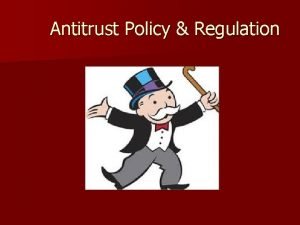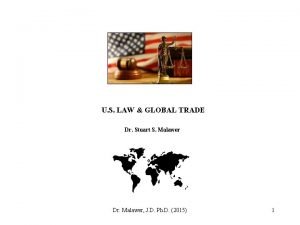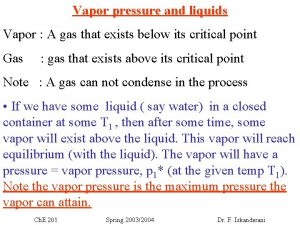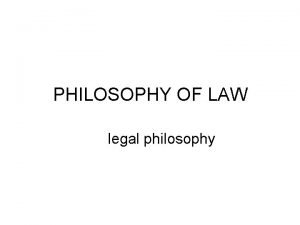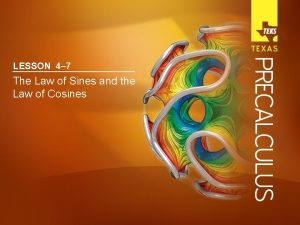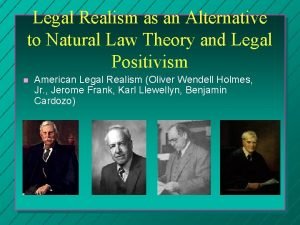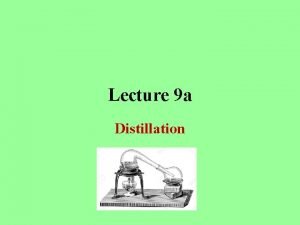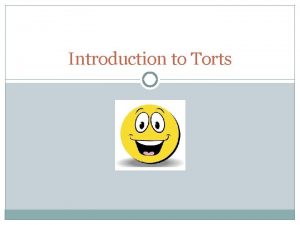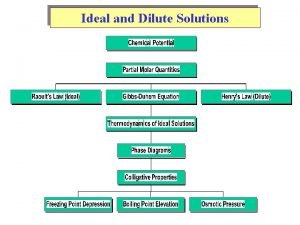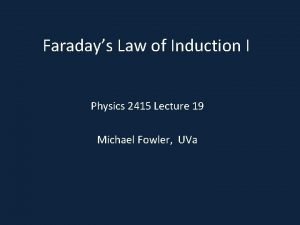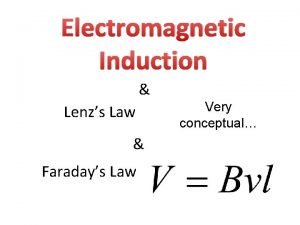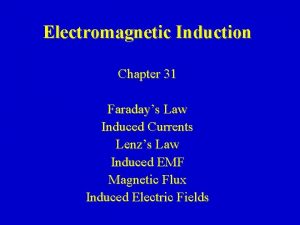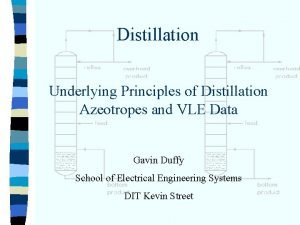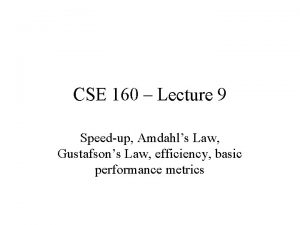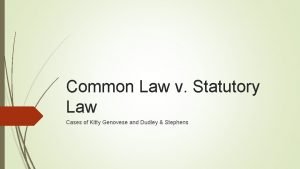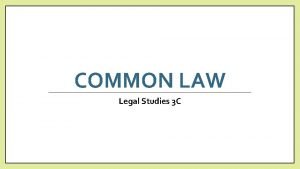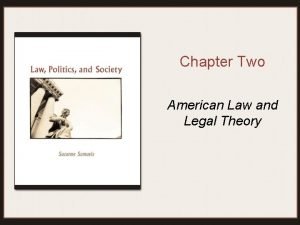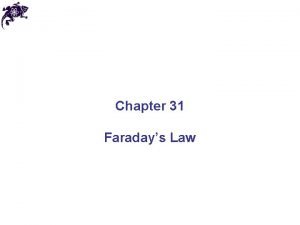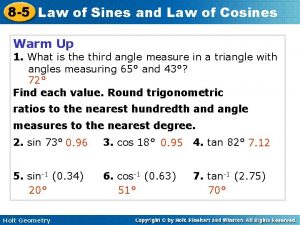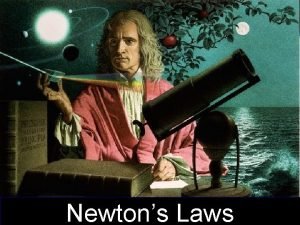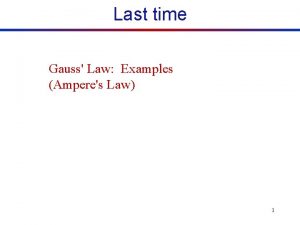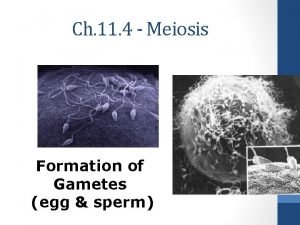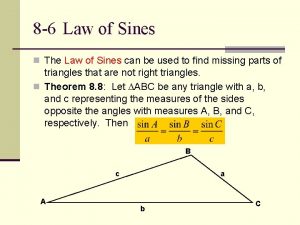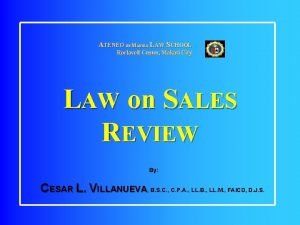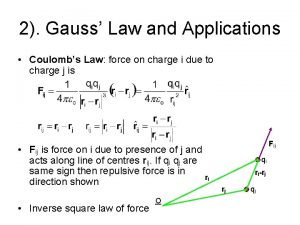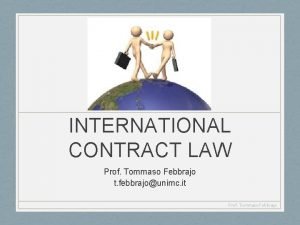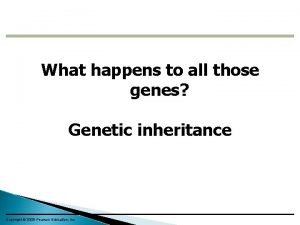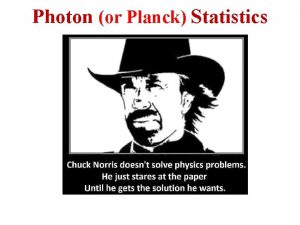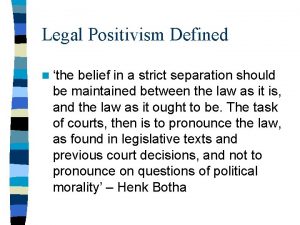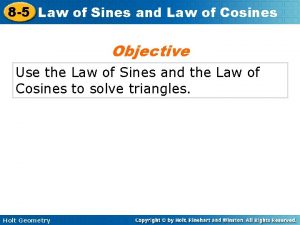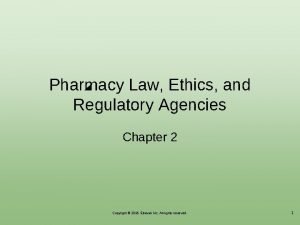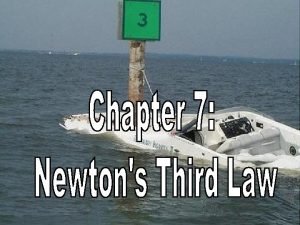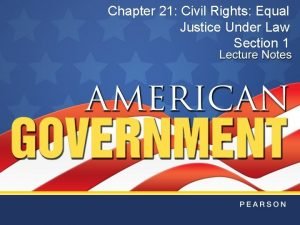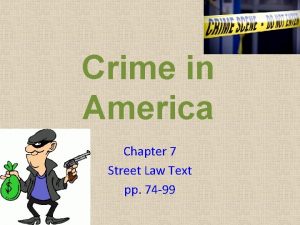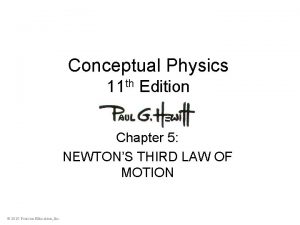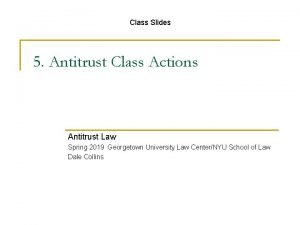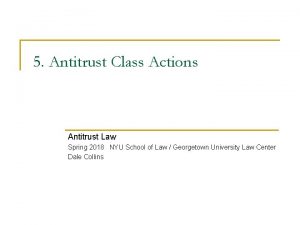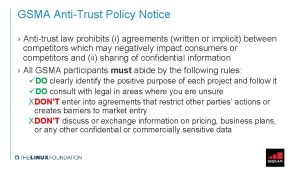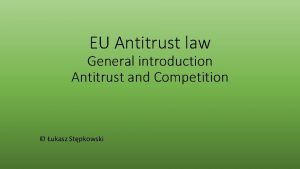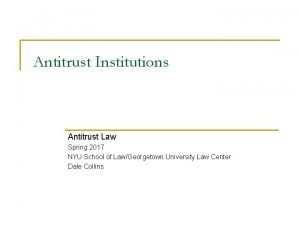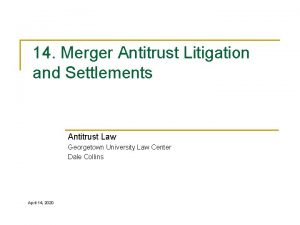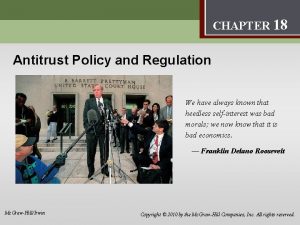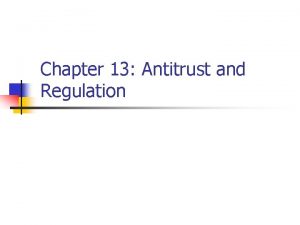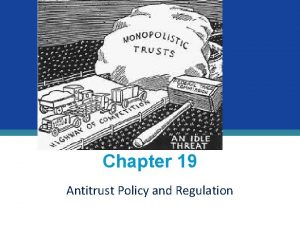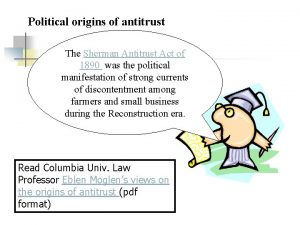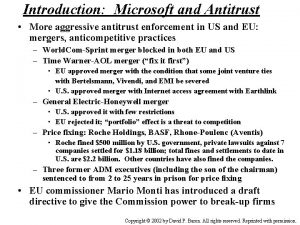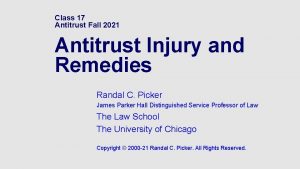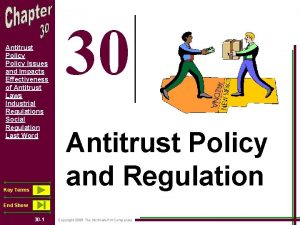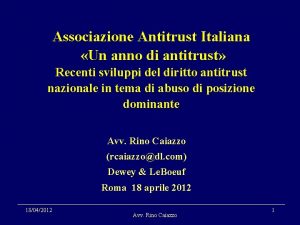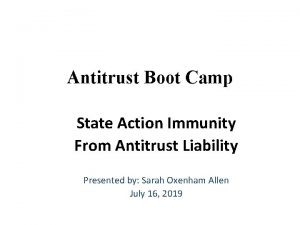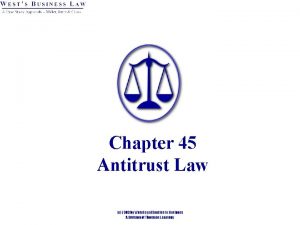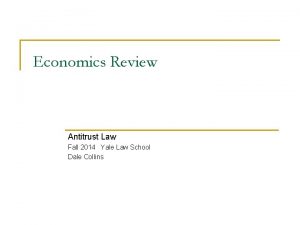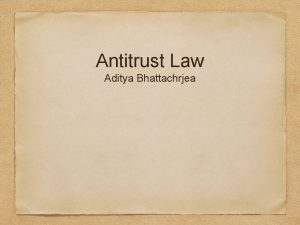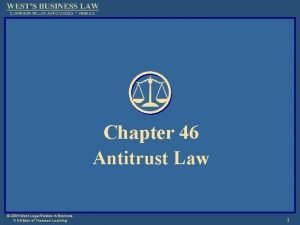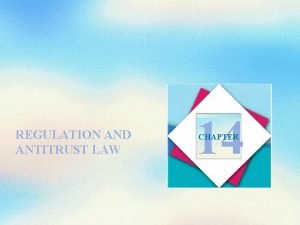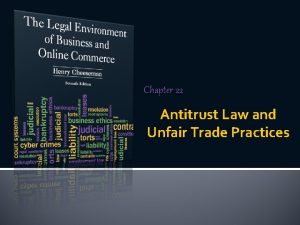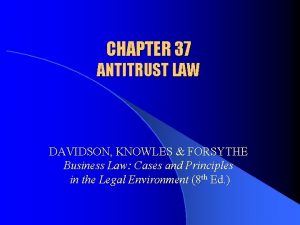Chapter 19 Antitrust Law Antitrust Law z Antitrust






















































- Slides: 54

Chapter 19 Antitrust Law

Antitrust Law z Antitrust law addresses prohibitions on attempts by competitors to restrain competition and injure competitors. z Antitrust statutes require the courts to determine what really constitutes antitrust law - therefore “Antitrust Law” refers to antitrust statutes and the interpretation of these statutes by the courts.

Federal Antitrust Legislation z Major Laws: y. Sherman Act y. Clayton Act (amended by Robinson-Patman) y. Federal Trade Commission Act z Courts generally must decide how they will be applied; most major cases brought by FTC or Department of Justice

The Sherman Act z Passed by Congress in 1890 z Regarded largely as a way to reduce concerns that large business interests dominated Congress. z The major sections of the Act are so broad that one could find almost any business activity to be illegal.

Exemptions z NOT ALL BUSINESSES ARE SUBJECT TO ANTITRUST LAWS z Clayton Act exempts some activities of nonprofit and certain agricultural/horticultural organizations z Labor unions, baseball. z Covenants not to compete. z Patents, copyrights. z Interstate Commerce Act allows the federal government to regulate motor, rail, air, and ship common carriers (public transport). If the government approves the actions of the businesses, the businesses are exempt. If they do not approve, antitrust laws apply. z The Export Trading Company Act allows limited antitrust immunity for export sellers who join together to enhance their ability to export (not very effective or much used). z Parker doctrine allows state government to restrict competition in public utilities & transportation and professional services (the state action doctrine).

The Sherman Act z Basically, two provisions: z Prohibits Agreements in Restraint of Trade; y. Need more than one party to have an agreement; z Prohibits monopolies or attempts to monop.

The Sherman Act z Prohibits Agreements in Restraint of Trade; y. Need more than one party to have an agreement. z Law prohibits all restraints of trade. Cannot possibly be done, so z Rule of Reason: Courts held that only unreasonable restraints were illegal. z Per se violations: Violations that are so anticompetitive, that they are automatically illegal. No defense.

The Sherman Act z Per se violations: y 1. Horizontal price fixing: Two or more competitors at the same level of distribution agree to charge the same price for competing goods. x. Two retailers, two wholesalers, two manufacturers. x. Prices can be fixed by buyers as well as sellers. x. Both minimum and maximum prices are prohibited. x. No defense that the price was reasonable. x. No defense that the price was the market price.

The Sherman Act z Per se violations: z 2. Vertical price fixing(a/k/a price resale maintenance. ): Two or more parties at different levels of distribution agree that goods will be sold at a fixed price. y. Retailer agrees with a manufacturer that these jeans will not be sold below $30 per pair.

+ and - to vertical price fix. z Small retailers favor RPM because they are more likely to have the same prices as the mass merchandisers. (Mom’n’Pop compete with Wal-Mart) z Producers of well-known, established products often favor RPM because it allow retailers to earn higher profits for the sale of their products. z Mass retailers oppose RPM because they have grown large by slashing retail prices and taking customers away from smaller stores.

The Sherman Act z Per se violations: y 3. Horizontal Market Divisions: Two or more competitors at the same level agree to divide the market between them. x. Geographically: one east, one west of the Miss. River. x. Agree not sell to the other’s customers.

The Sherman Act z Per se violations: z 4. Joint Boycotts (refusals to deal): Two or more competitors agree not to deal with a third party. y. All the beer distributors in Vigo county agree not to sell to Harmon Pizza Co. y. Result can be achieved independently, but not jointly. y. Current case over NFL rules that player must be out of high school 3 yrs. before entering NFL.

FTC v. Superior Court Trial Lawyers Assn. (1990) Use of boycott to force compliance with price-fixing or some other restraint of trade z Group of lawyers worked as court-appointed attorneys for criminal defendants. Attorneys belong to the Superior Court Trial Lawyers Assn. (SCTLA), a private organization. Fees for work were $30/hour for court time; $20/hour for out-of-court time. They demanded their pay be doubled. When it didn’t happen, attorneys boycotted the criminal courts and brought system to a stop. D. C. raised attorney fees to $35/hour & promised to double fees ASAP. z FTC charged SCTLA with conspiracy to fix prices and to conduct a boycott that constituted unfair methods of competition under Section 5 of FTC Act. The Commission ruled the boycott illegal per se. Court of appeals reversed on grounds of 1 st Amendment political free speech. z HELD: Supreme Court reversed, saying the per se rules apply to the boycott. It is “no excuse that the prices fixed are. . . reasonable. ” This boycott “almost produced a crisis” to achieve “its economic goal. ”

The Sherman Act z Per se violations: z 5. Tying Agreement: Seller forces buyer to buy an unwanted product (dog) in order to buy a desired (hot) product. y. If you want to buy a Cabbage Patch doll, you have to buy a cap gun. y. Only per se if seller has sufficient market power. y. Exception: Full Line Doctrine.

The Sherman Act z Rule of Reason violations z Vertical Market Divisions: Manufacturer divides up the country into exclusive sales territories and gives them to different distributors. (auto dealers in county) y. This limits intrabrand competition, but not interbrand competition, so not as dangerous. y. Illegal only if unreasonable. Court find legal.

NCAA v. Board of Regents of University of Oklahoma (1984) z OU brought suit against the NCAA, claiming the NCAA was a cartel that fixed prices and limited output. OU wanted to show more football games and knew it could get paid more by the networks than the NCAA allowed. The lower courts ruled for OU stating that the NCAA’s television plan was per se illegal price-fixing. z HELD: Affirmed. Supreme Court agreed that the NCAA was prohibiting competition among its member institutions, but stated that it should be judged under the rule of reason, not the per se rule because of the peculiar nature of the market that required colleges to cooperate.

Exchanges of Information Sharing z Problem: Is the trading of information among businesses helping or restraining the competitive process. z U. S. v. United States Gypsum Co. ~ The gypsum companies defended their practice of verifying competitors’ prices as a good-faith effort to meet competition. The court did not apply a per se rule against the information exchange; it warned that exchanges would be examined closely and allowed in limited circumstances. The more open the information, the better. Conspiracy to Restrain Information z May be illegal to band together to restrain the sharing of information. z FTC v. Indiana Federation of Dentists ~ Court held that dentists’ organization policy requiring members to withhold Xrays from dental insurance companies is a conspiracy in restraint of trade under a rule of reason.

The Sherman Act–Section 2 z Monopolies and Attempts to Monopolize. y. Monopoly: Company has power to fix prices or exclude competitors from market. y. To be illegal, power must be gained from a Predatory Practice (bad act). x. Alcoa Aluminum-Excess Capacity; x. Alcoa Aluminum-Buying all raw materials; x. Tobacco companies – Buying all raw materials; x. Lone Star Beer case-Selling below cost to drive out competitors. y. Monopoly must relate to a Relevant Market; what market is trying to be monopolized.

Market Power Includes Market Share – percent of relevant market controlled by the firm Product Market – a monopoly exists when there is only one firm producing a product for which there is no good substitute. Geographic Market – generally limited to the area where consumers can reasonably be expected to make purchases.

The Sherman Act–Section 2 z Monopolies and Attempts to Monopolize. y. Defenses x. Superior business acumen (practices); x. Government grant of Monopoly; x. Thrust upon defense; Coors Beer case. y. Monopoly must relate to a Relevant Market; what market is trying to be monopolized. x. Du Pont cellophane case. x. Cabbage Patch Dolls x. Coke

Enforcement of Antitrust Laws z Sherman Act ~ Violations of Sections 1 and 2 of the Sherman Act are criminal felonies. ~ Private parties or the government can seek injunctive relief under the Act in a civil preceding. ~ Private parties who have been harmed by a violation of the Sherman Act can sue for treble damages. z Clayton Act - Penalties are different than under Sherman act - FTC can issue cease and desist orders, which prohibit further violation by a party. z FTC Act - Penalties range from an order preventing a planned merger to substantial civil penalties.

Remedies Available Government can: z restrain a company or individual from performing certain z z actions force a company to sell part of its assets use company assets to form another company to compete with original company force a company to let others use its patents or facilities cancel or modify existing business contracts

The Clayton Act z Enacted in 1914 z Wanted government to have the ability to attack a business practice early in its use to prevent a firm from becoming a monopoly as well as attack a monopoly after it has been formed. y. Under Sherman Act, had to wait until after merger, then try to un-merge. z Congress can attack business activities when effect was to “substantially lessen competition or tend to create a monopoly. ”

Robinson-Patman Act z Enacted in 1936, it amends the Clayton Act. z The controversial section 2(a) basically states that a seller is said to engage in price discrimination when the same product is sold to different buyers at different prices. z Price Discrimination - many cases under Robinson Patman are alleged economic injuries either from a firm charging different prices in different markets or from bulk sale discounts given to larger volume retailers. z Predatory pricing - when Company A attempts to undercut Company B in an effort to drive Company B from the market. When B is gone, A raises prices again.

Price Discrimination z. Any price discrimination where the effects may be to “substantially lessen competition or tend to create a monopoly” is prohibited. z. It is clear that charging two customers different prices for the same goods is discrimination. y. Obviously, must affect significant volume to affect competition. Action may be illegal for large company, but not for small company.

Price Discrimination z. Defenses: y 1. Quantity discounts are allowed if the discounts truly reflect the decreased cost of manufacture, sale or delivery. Seller must prove the decrease. y 2. To meet lawful competition, price discrimination may occur. x. Meet, not beat competition. y 3. Change in market: obsolescence or perish. y 4. No affect on competition.

Price Discrimination z. Ford cannot charge Dealership A more than it charges Dealership B in Terre Haute. z. Ford cannot charge a dealership in NYC more than it charges in Terre Haute, Except for shipping. z. Special rebates, commissions, discounts are prohibited unless equivalent. z. Cannot sell same goods with different labels for different price: need quality diff.

Tying Arrangements z. Already seen that they are illegal under Sherman Act; may also be illegal under Clayton Act. z. Must “substantially lessen competition or tend to create a monopoly”

Exclusive Dealing Arrangements z. Buyer agrees that it will handle seller’s product, but will not sell any of seller’s competitors products. y. Illegal only if substantially lessen competition or tend to create a monopoly. y. Kroger’s agrees to sell Kellogg’s cereal, but not Post cereals. y. Coke at Mc. Donald’s; Pepsi at Burger King.

Requirements Contracts z. Buyer agrees to buy all of a needed product from one seller. y. Illegal only if substantially lessen competition or tend to create a monopoly. y. GM agrees to buy all its glass from PPG.

Mergers Merger – When two or more firms come together to form a new firm. Horizontal merger – The two or more firms were competitors before the merger. Mergers should not be permitted to significantly enhance market power. Merging firms must notify FTC or Justice in advance under Hart. Scott-Rodino so it can be studied for possible opposition.

Mergers (cont) z. Horizontal – same level of distribution; y. Kroger’s merges with Marsh. z. Vertical – different levels of distribution; y. Paper producer merges with lumber co. z. Conglomerate – different markets. y. Reynolds Tobacco with Nabisco foods. z. Product line extension – to get certain product y. Proctor and Gamble and Clorox.

Standard Oil of New Jersey v. U. S. (1911) z Government sued under Sections 1 & 2 of the Sherman Act to break up Standard Oil Trust which controlled as much as 90% of production, shipping, refining and selling of petroleum products, thus allowing the Trust to fix the price of oil and monopolize interstate commerce. z The Trust was ordered to cease and desist in actions that violate the Sherman Act and the Trust was broken up so that companies would operate independently and compete with each other.

U. S. v. Philadelphia National Bank (1963) z PNB and Girard Trust banks wanted to merge which would create the largest bank in Philadelphia. z Government sought to enjoin the merger. The lower court ruled for the bank. z HELD: Supreme Court reversed the lower court decision. Stopped the merger. z Supreme Court stated that its major task was to determine, “where, within the area of competitive overlap, the effect of the merger on competition will be direct and immediate. ” z Merger would give the two largest banks a 59% share of the four-county area it determined to be the appropriate “section of the country. ”

Potential Competition z. The Supreme Court has stated that the possibility that the two companies are potential competitors may be enough to stop a merger. z. FTC v. Procter & Gamble: Merger between Proctor & Gamble and Clorox was prohibited because of “potential competition”. Clorox had 49% of the liquid bleach sales; the Court thought it important that Clorox not be given further dominant positions by merging with a large company like P&G. The Court wanted Clorox to be faced with the threat of strong potential competition by a company like P&G.

Merger Defenses z Failing firm defense - If one of the firms involved in a merger has been facing bankruptcy or circumstances that threaten the firm, the Court will look more favorably upon the merger. The firm must show: y not likely to survive without merger y no other buyers, or this one will least affect competition y tried and failed at all other ways to save firm z Power buyer defense – A merger that increases concentration to high levels can be defended by showing that the firm’s customers are sophisticated and powerful buyers.

U. S. v. General Dynamics Corp. (1974) Sophisticated buyers defense. z General Dynamics, a deep-mining coal producer, wanted to buy another coal-producer. Government opposed - it would give GD a 22% share of the Illinois market. z Lower court ruled for GD stating that coal, a declining industry, was closing market share in energy production market. z HELD: Supreme Court affirmed the lower court decision. z The statistical information provided by the government was insufficient to sustain its case. In some markets, can’t just look at $ sales to determine if one company would control a large share of the market. Must look at other factors also--in this case uncommitted reserves of recoverable coal. Buyers of coal are sophisticated utilities able to make good, longterm contracts.

End of Chapter 19

U. S. v. Sealy, Inc. (1967) z Sealy licensed independently owned manufacturers to make and sell mattresses under the Sealy name. Sealy set minimum retail prices and territorial divisions among its licensees. z The trial court held that the pricing practices were per se illegal, but the territorial restrictions were not an unreasonable restraint of trade. z Supreme Court held that the territorial limitations were part of, “an aggregation of trade restraints including unlawful price-fixing and policing. ”

Vertical Restraints of Trade z Vertical restraints of trade concern relationships between buyers and sellers (producers, distributors and retailers). A company that does more than one function internally, such as manufacturing and distribution, is not constrained by the antitrust laws. z Examples of vertical restraints of trade include vertical price fixing and vertical non-price constraints.

Vertical Nonprice Restraints z Manufacturers frequently impose non-price restraints on their distributors and retailers. y Example: Coke and Pepsi have territorial restrictions on the sale of the manufacturer’s products. Delivery in competition with another bottler is grounds for revocation of the franchise agreement. z Customer restrictions may be imposed on distributors and retailers when manufacturer elects to sell directly to a certain customer. y Since its first decision on a vertical non-price restraint, the Supreme Court generally applied the rule of reason. (White Motor Company v. United States)

Territorial Restraints z In most territorial restraint cases a manufacturer is in the process of implementing a vertical territorial restraint strategy. z Manufacturer terminates the retailer or distributor in the process. z A manufacturer eliminates some distributors so that the remaining distributors have the necessary exclusivity to be successful. z The retailer or distributor, harmed by the manufacturer’s action, often sue, asserting that the manufacturer is attempting to monopolize the market.

Business Electronics v. Sharp Electronics (1988) z Sharp appointed Business Electronics and Hartwell as retailers in Houston. Sharp published a list of suggested retail prices, but retailers were not bound by them. z BE sold Sharp calculators below both Sharp’s suggested retail price and Hartwell’s price. Hartwell wanted Sharp to terminate BE; Sharp did. BE sued Sharp for conspiracy under the Sherman Act. z The trial court ruled for BE, but the appeals court reversed. z HELD: The judgment of appeals court affirmed. z Manufacturers often want to ensure distributors earn sufficient profit to pay for programs such as hiring and training additional salesman or demonstrating the technical features of the product, and will not want to see free-riders interfere. Inter-brand competition may be more important than intra-brand competition. Vertical restraints are not per se illegal unless they include clear agreement on prices.

Exclusionary Practices Various business practices are designed to indirectly exclude competitors from a particular market. Such practices, which include tying arrangements, exclusive-dealing agreements, and boycotts, may violate antitrust laws if their effect is anticompetitive.

The Federal Trade Commission Act z Enacted in 1914 z Established the FTC as an agency to investigate and enforce violations of antitrust laws. z Declares it illegal to be engaged in “unfair methods of competition” - any business activity that may create a monopoly by unfairly eliminating or excluding competitors from the marketplace.

z To win a predatory pricing (price discrimination) case a plaintiff must present evidence that · Defendant priced below cost · Below cost pricing created a genuine prospect for defendant to monopolize the market · Defendant would enjoy monopoly long enough to recoup losses suffered during price war · Defenses z Cost justification - Difference in transportation costs – a) more expensive to drive further and b) it’s cheaper unit to deliver 500 refrigerators versus 10 z Meeting competition - Firm cuts its price in order to meet competition. It must be done in good faith, not in an effort to injure competitors but to stay competitive

Texaco v. Hasbrouck (1990) z Texaco sold gasoline to Hasbrouck and other independent Texaco gas stations. It also sold to Gull and Dompier at lower prices, who sold the gasoline for less at retail. z Sales at Hasbrouck’s & other stations dropped from 76% to 49%. z Dompier used his own tanker trucks to pick up gasoline from Texaco. Other dealers asked Texaco if they could do the same and get Dompier’s and Gull’s price. Texaco said no. z Hasbrouck and others sued Texaco for price discrimination. z Trial Court awarded treble damages to Hasbrouck. Ct. of Appeals affirmed. Texaco appealed and said discounts were given due to the role of Gull and Dompier in “the supplier’s distribution system” reflecting services that these purchasers performed. z HELD: Judgment affirmed. Texaco discriminated in its pricing. z This price differential injured competition. z The functional discounts were not legal under Section 2(a) of the Robinson-Patman Act.

U. S. v. Trenton Potteries Co. (1927) z Defendants were members of the Sanitary Potter’s Association and produced 82% of the sanitary pottery in the U. S. They admitted that they fixed prices and limited sales. They argued that the trial court should have submitted to the jury the question of whether the pricefixing agreements were unreasonable. z HELD: S. Ct. reinstated the district court judgment. z The power to fix prices, whether reasonably exercised or not, involves the power to control the market and to fix unreasonable prices. It is per se illegal. It is not up to the government or jury to determine if a fixed price is reasonable.

Horizontal Restraints of Trade z When businesses at the same level of operation come together in some manner, they risk being accused of restraining trade. z Examples: y. Mergers y. Horizontal price-fixing y. Exchanges of information y. Territorial restrictions y. Cartels such as Organization of Petroleum Exporting Countries (OPEC)

Tying Arrangements z Tie-ins meet a rule of reason test so long as competitive alternatives exist. z If a tie-in creates a monopoly when there are no or few good alternatives, it is likely illegal; if products or service are tied together when there are competitors, the tie-in will likely pass the rule of reason test. z Supreme Court is likely to impose a per se illegality only when three conditions are met: y The seller has market power in the tying product y Tied and tying products are separate y There is evidence of substantial adverse effect in the tied product market z In other situations the rule of reason approach is to be employed.

The Per Se Rule and The Rule of Reason z Per Se Rule means that a certain business agreement, arrangement, or activity will automatically be held to be illegal by the courts. z Rule of Reason means that the court will look at the facts surrounding an agreement, arrangement, or other restraint before deciding whether it helps or hurts competition. Courts consider: y history of the restraint y business reasons behind the restraint y business’s position in the industry y structure of the industry

Horizontal Price-Fixing z The Sherman Act prohibits “every contract, combination or conspiracy, in restraint of trade or commerce among the several states, or with foreign nations. ” z Thus when firms selling the same product agree to fix prices, the agreement will almost certainly violate the Sherman Act. z Should Per-Se Illegal apply or Rule of Reason? z The Supreme Court had ruled that horizontal pricefixing is per se illegal. But they also say that any one company has the right to charge whatever price it wishes and in some cases it may help markets to work better. z See United States v. Trenton Potteries z But see also NCAA v. Board of Regents of University of Oklahoma

Vertical Price Fixing z Usually trying to control price at which product is sold to consumer. z Resale Price Maintenance – (RPM) - an agreement between a manufacturer, supplier and retailers of a product under which the retailers agree to sell the product at not less than minimum price. z Once a producer or supplier sells a product to a retailer, it cannot fix or otherwise dictate the price the retailer will charge consumers.

Territorial Restrictions z Occurs when firms competing at the same level of business reach an agreement to divide the market to eliminate competition among those firms. z These are often held to violate antitrust law. z An activity that is legal if undertaken by a single firm may be illegal if undertaken by a group of firms.
 Oil spill
Oil spill Antitrust laws
Antitrust laws Antitrust laws
Antitrust laws Newton's first law and second law and third law
Newton's first law and second law and third law Newton's first law and second law and third law
Newton's first law and second law and third law V=k/p
V=k/p Constant of avogadro's law
Constant of avogadro's law Raoult's law and dalton's law
Raoult's law and dalton's law Difference between civil law and criminal law
Difference between civil law and criminal law Natural law vs positive law
Natural law vs positive law Natural law vs positive law
Natural law vs positive law Stoicism natural law
Stoicism natural law Mendel's law of dominance
Mendel's law of dominance 4-7 the law of sines and the law of cosines
4-7 the law of sines and the law of cosines Positive law vs natural law
Positive law vs natural law Introduction of distillation
Introduction of distillation Criminal law plaintiff
Criminal law plaintiff Thermodynamics equations
Thermodynamics equations Gregor mendel data
Gregor mendel data Lenz's law
Lenz's law Faraday's law vs lenz's law
Faraday's law vs lenz's law Faraday law of electromagnetic induction
Faraday law of electromagnetic induction Antoine equation
Antoine equation Gustafson's law
Gustafson's law Difference between statute and common law
Difference between statute and common law Difference between common law and statute law
Difference between common law and statute law Principles of natural law
Principles of natural law Faraday's law vs lenz law
Faraday's law vs lenz law Natural law vs positive law
Natural law vs positive law Private law vs public law
Private law vs public law Law of sines and law of cosines quiz part 1
Law of sines and law of cosines quiz part 1 Raoult's law for non volatile solute
Raoult's law for non volatile solute Newton's law of motion
Newton's law of motion Faraday's law
Faraday's law Chromo
Chromo 8-6 the law of sines
8-6 the law of sines Law is order and good law is good order
Law is order and good law is good order Dacion en pago vs pactum commissorium
Dacion en pago vs pactum commissorium Gauss law in vector form
Gauss law in vector form Common law and civil law
Common law and civil law Common law and civil law
Common law and civil law International contract
International contract Law of independent assortment vs law of segregation
Law of independent assortment vs law of segregation Coulomb's law formula for magnitude
Coulomb's law formula for magnitude Planck radiation law
Planck radiation law When to use cosine rule
When to use cosine rule Positivism
Positivism 8-5 law of sines
8-5 law of sines Chapter 2 pharmacy law ethics and regulatory agencies
Chapter 2 pharmacy law ethics and regulatory agencies Chapter 766
Chapter 766 Chapter 7 newton's third law
Chapter 7 newton's third law Chapter 21 civil rights equal justice under law
Chapter 21 civil rights equal justice under law Chapter 5 section 1 supply and the law of supply
Chapter 5 section 1 supply and the law of supply Chapter 7 crime in america
Chapter 7 crime in america Conceptual physics chapter 5 newton's third law of motion
Conceptual physics chapter 5 newton's third law of motion
